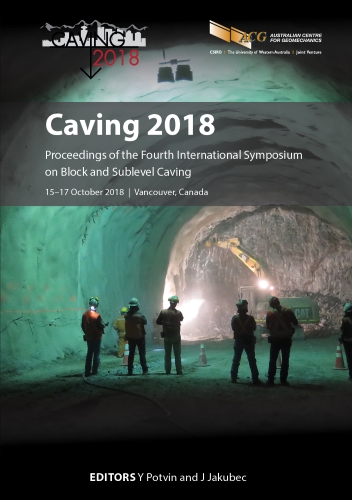Design of a new layout for sublevel caving at depth

|
Authors: Quinteiro, C |
DOI https://doi.org/10.36487/ACG_rep/1815_33_Quinteiro
Cite As:
Quinteiro, C 2018, 'Design of a new layout for sublevel caving at depth', in Y Potvin & J Jakubec (eds), Caving 2018: Proceedings of the Fourth International Symposium on Block and Sublevel Caving, Australian Centre for Geomechanics, Perth, pp. 433-442, https://doi.org/10.36487/ACG_rep/1815_33_Quinteiro
Abstract:
LKAB has been mining iron ore with the sublevel caving mining method in northern Sweden for more than 60 years. Throughout the years, LKAB has improved this mining method to stay competitive in a tough international iron ore market. Improvements in drilling and blasting technology have helped LKAB increase the scale of sublevel caving and therefore decrease its mining costs in development. Today, sublevels at LKAB are up to 30 m high. In recent years, with increasing mining depth LKAB has been experiencing decreased availability of some production areas due to rockfalls induced by seismicity and orepass instabilities. LKAB started a study in 2017 to investigate mining under the current main level both at the Kiruna mine and Malmberget mine. This paper presents part of the results of this study, which is a novel layout for sublevel caving that is more suitable for mining under high horizontal stress and with higher production capacity than the existing layout. This layout has been internally named ‘fork layout’, since its basic layout looks like a drawing of a fork. This layout divides the orebody into contiguous production areas. A production area is formed by several crosscuts linked together by a transport drift. It is expected that this new layout will have a significantly higher production capacity than the existing transversal sublevel caving layout, and will be more suitable for mining at depth compared with the existing layout. One of the drawbacks of this new layout is the need for more development work than the traditional layout. To decrease the economic impact of this effect on mining costs, a further increase in the sublevel from about 30 to 50 m high is suggested. This layout is being considered for approval by the LKAB board to a full-scale test at Kiruna.
Keywords: sublevel caving, mine design, caving mechanism, high induced stress
References:
LKAB 2018, Annual and Sustainability Report 2017, LKAB, Luleå, pp. 25–28.
© Copyright 2025, Australian Centre for Geomechanics (ACG), The University of Western Australia. All rights reserved.
View copyright/legal information
Please direct any queries or error reports to repository-acg@uwa.edu.au
View copyright/legal information
Please direct any queries or error reports to repository-acg@uwa.edu.au
